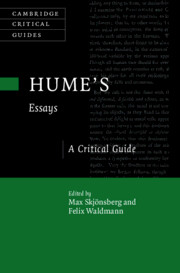Book contents
- Hume’s Essays
- Cambridge Critical Guides
- Hume’s Essays
- Copyright page
- Dedication
- Contents
- Figures
- Contributors
- Acknowledgements
- Abbreviations
- Introduction
- Part I Reception
- Part II Philosophy
- Part III Politics
- Part IV Political Economy
- Chapter 11 Hume and Population
- Chapter 12 Hume on Economic Inequality
- Chapter 13 Hume and the Politics of Money
- Bibliography
- Index
- Cambridge Critical Guides
Chapter 11 - Hume and Population
from Part IV - Political Economy
Published online by Cambridge University Press: 02 January 2025
- Hume’s Essays
- Cambridge Critical Guides
- Hume’s Essays
- Copyright page
- Dedication
- Contents
- Figures
- Contributors
- Acknowledgements
- Abbreviations
- Introduction
- Part I Reception
- Part II Philosophy
- Part III Politics
- Part IV Political Economy
- Chapter 11 Hume and Population
- Chapter 12 Hume on Economic Inequality
- Chapter 13 Hume and the Politics of Money
- Bibliography
- Index
- Cambridge Critical Guides
Summary
“Of the Populousness of Ancient Nations” is by far the longest of Hume’s essays. Although it does not always receive the attention it merits, it is a very important text not only in relation to Hume’s political thought as a whole but also for a full understanding of the intellectual history of the long eighteenth century as it partook in a set of wide-ranging conversations about the causes of demographic growth in which T. R. Malthus, amongst others, became engaged. This chapter first revisits Montesquieu’s position on the issue of the relative populousness of ancient and modern nations to show not only the true nature of the Frenchman’s views and that of the dispute between him and Hume but also the extent to which Hume’s reading of Montesquieu provided the basis for the Scot’s reflections on republics, liberty, the status of women and slavery in that essay and elsewhere. It underscores the centrality of demography to political debates of the period.
- Type
- Chapter
- Information
- Hume's EssaysA Critical Guide, pp. 207 - 223Publisher: Cambridge University PressPrint publication year: 2025

